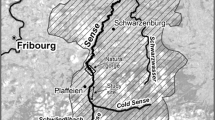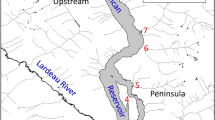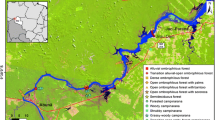Abstract
Impoundments in the upper Tennessee River Basin have inundated historic river riparian and mesic valley slope habitats. Fifteen major Tennessee Valley Authority (TVA) reservoirs, upstream of Chattanooga TN, have effected 50,000 ha of modern reservoir riparian zones on formerly mesic terrain. These zones were defined here as winter mudflats between winter pool shores and summer pool shores and summer riparian habitats with diminishing soil saturation from summer shores up to flood zone boundaries. Watts Bar (WB), the largest of these 15 projects in terms of area, was chosen for background and field analyses of the consequential reservoir riparian processes and expressions. WB, at the median age of areal TVA reservoirs, was closed in 1942. Transects were taken in the WB summer riparian forest after consideration of topoedaphics, species composition, and the level of contemporary disturbance. Regional bottomland forests were compared. Coefficients of species similarity showed 70% compositional similarity. The basal area (BA) density of WB summer riparian forests was not similar as was composition in regional bottomland stands. Four (of twelve) subjectively selected WB transect BA densities were compared nonparametrically and were the same (90% confidence) as other bottomland stands of like chronology. Overall however, WB stands averaged 19.6 m2/ha BA to 30.0 + for regional comparisons. Stocking was low, but measured litterfall was relatively high, resulting in similar biomass productivity corrected on a unit area basis. The winter mudflats showed expanding development of phenologically distinct herbaceous and graminoid communities under a five to six month drawdown exposure regime. Thermal modifications from the winter pool heat sink were determined to alter the mudflat microenvironment. A recent shortening of the drawdown period has interrupted the adapted life history strategy of the counter-seasonal plants, and seed maturity has been restricted. Erosion of the summer shore has been increasing the extent of the mudflats at the expense of the hydrologically influenced summer riparian habitat foreslope. The discernable trend of summer riparian stand succession over mesic expression will be limited by the height and hydric avoidance occasioned by an abrupt slope to mesic, unsaturated profile, conditions. Approximations of biomass production potential pre- and post impoundment have shown a 12∶1 diminution from historic carbon detention, on a seasonal basis, within normal pool shore boundaries. Further approximations comparing the WB summer riparian forest carbon retention and detention to historic forest compartments highlighted the importance of a relatively copious, non-lignified, litterfall in the seasonally available carbon budget.
Similar content being viewed by others

References
Amundsen, C.C.: 1989, Reservoir interpool plant habitat dynamics I, in: Quinones, F. and Balthrop, B.H. (eds), Abstracts of the Second Term. Hydrology Symp. p. 92.
Amundsen, C.C.: 1992, Reservoir interpool plant habitat dynamics IV, in: Quinones, F. and Hoadley, K.L. (eds), Abstracts of the Fifth Tenn. Water Resources Symp. pp. 102–105.
Amundsen, C.C.and Bartlett, E.B.: 1990, Reservoir interpool plant habitat dynamics II, in: Sale, M.J. and Presley, P.M. (eds), Extended Abstracts of the Fourth Tenn. Water Resources Symp. pp. 180–183.
Amundsen, C.C.: 1991, Reservoir interpool plant dynamics III, in: Sale, M.J. and Presley, P.M. (eds), Extended Abstracts of the Fourth Tenn. Water Resources Symp. pp. 141–144.
Brenkert, A.L., Brandt, C.C., Rose, K.A., Cook, R.B., Wood, M.A., Beard, L. and Schohl, G.A.: 1992, A comparison of two methods for estimating spatial patterns of sediment accumulation in the Clinch River-Watts Bar reservoir system, in: Quinones, F. and Hoadley, K.L. (eds), Extended Abstracts of the Fifth Tenn. Water Resources Symp. pp. 78–81.
Brower, J.E. and Zar, J.H.: 1984, Field Laboratory Methods for General Ecology. Wm. C. Brown.
Carter, V. and Burbank, J.H.: 1978, Wetland Classification System for the Tennessee Valley Region, Tennessee Valley Authority Tech. Note, No. B24.
Clebsch, E.E.C.: 1989, Vegetation of the Appalachian Mountains of Tennessee east of the Great Valley. J. Tenn. Acad. Sci. 64, 79–83.
Core, E.L. and Ammons, N.P.: 1958, Woody Plants in Winter. Boxwood Press.
Fredrickson, L.H. and Reid, F.A.: 1986, Wetland riparian habitats: a nongame management overview, in: Hale, J.B., Best, L.B. and Clawson, R.L. (eds), Management of Nongame Wildlife in the Midwest: A Developing Art. North Central Section Wildlife Society, Chelsea, MI. pp. 59–96.
Gara, B.D. and Stuckey, R.L.: 1992, Life-form spectra of the mudflat flora on the Scioto River, Delaware County, Ohio. SIDA 15. pp. 289–303.
Hall, T.F. and Smith, G.E.: 1955, Effects of flooding on West Sandy Dewatering Project, Kentucky Reservoir. J. Forestry 53, pp. 281–285.
Leidy, R.A., Fiedler, P.L. and Micheli, E.R.: 1992, Is wetter better? Bioscience 42, pp. 58–65.
McGinnis, J.T.: 1958, Forest litter and humus types of East Tennessee. MS Thesis, University of Tennessee, Knoxville.
Mann, L.K. and Bierner, M.W.: 1975, Oak Ridge, TN, Flora: Habitats of the vascular plants/Revised inventory. E.S.D. Publication No. 775, Oak Ridge National Laboratory, p. 141.
Meinert, D.L.: 1991, Reservoir vital signs monitoring. 1990. Tennessee Valley Authority TVA/WR/WQ- 91/10.
Odum, E.P.: 1993. Ecology and Our Endangered Life Systems. Sinauer Associates.
Olson, J.S.: 1970, Carbon cycles and temperate woodlands, in: Reichle, D.E., (ed), Analyses of Temperate Forest Ecosystems. Springer-Verlag, pp. 226–241.
Ploskey, G.R.: 1985, Impacts of terrestrial vegetation and preimpoundment clearing on reservoir ecology and fisheries in the United States and Canada. FAO Fish. Tech. Pap., 258. United Nations.
Rheinhardt, R.: 1992, A multivariate analysis of vegetation patterns in tidal freshwater swamps of lower Chesapeake Bay, U.S.A. Bull. Torrey Botanical Club, 119, pp. 192–207.
Rosson, J.F. Jr.: 1992, Compiled US Forest Service Inventory Data, Tennessee. Starkville, Mississippi.
Sain, J.E., Fonferek, W.J., Simpson, M.S. and Whittingham, K.W.: 1984, First year vegetation following exposure of the Edmonson Lake Bed, Washington County Va. Castanea 49. pp. 158–166.
Satoo, T.: 1970, A synthesis of studies by the harvest method: primary production relations in the temperate deciduous forests of Japan, in: Reichle, D.E. (ed), Analyses of Temperate Forest Ecosystems. Springer-Verlag, pp. 55–72.
Smith, H.D., Hafley, W.L., Holley, D.L. and Kellison, R.C.: 1975, Yields of mixed hardwood stands occurring naturally on a variety of sites in the Southeastern United States. Tech. Rep. 55, School of Forest Resources, North Carolina State Univ.
Smith, R.L.: 1992, Elements of Ecology. Harper and Collins.
Springer, M.E. and Elder, J.A.: 1980, Soils of Tennessee. Univ. Tenn. Ag. Exp. Sta. Bull. 596.
Shanks, R.E.: 1952, Checklist of the woody plants of Tennessee. J. Tenn. Acad. Sci. 27, pp. 223–229.
Swift, B.L.: 1984, Status of riparian systems in the United States. Water Res. Bull. 20, pp. 223–229.
Tanner, J.T.: 1978, Guide to the Study of Animal Populations. Univ. Tenn. Press.
Tilman, D.L.: 1988, Plant Strategies and the Dynamics and Structure of Plant Communities. Princeton Univ. Press.
Tiner, R.W.: 1991, The concept for a hydrophyte for wetland identification. BioScience 41, pp. 236–247.
Tennessee Valley Authority: 1980, Water control projects. Tech. Monog. 55, Volume 1.
Webb, D.H. and Bates, A.L.: 1989, The aquatic vascular flora along rivers and reservoirs of the Tennessee River System. J. Tenn. Acad. Sci. 64, pp. 197–203.
Wofford, B.E.: 1989, Guide to the Vascular Flora of The Blue Ridge. Univ. Georgia Press.
Author information
Authors and Affiliations
Rights and permissions
About this article
Cite this article
Amundsen, C.C. Reservoir riparian zone characteristics in the Upper Tennessee River Valley. Water Air Soil Pollut 77, 469–493 (1994). https://doi.org/10.1007/BF00478434
Issue Date:
DOI: https://doi.org/10.1007/BF00478434



